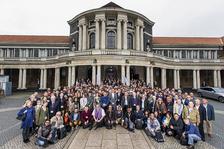Participants of the ICAME2015. (Photo DESY/ L. Berg)
The “International Conference on the Applications of the Mössbauer Effect” (ICAME 2015) is being held in Hamburg from 13 to 18 September. The conference has been staged biennially for almost 50 years now, at changing global venues, regularly attracting 200 to 300 participants from over 40 different countries. The congress is dedicated to scientific applications of the Mössbauer effect, which has become an indispensable tool both in fundamental research and in modern materials science.
How do proteins work? How did our ancestors manufacture their tools? Has there ever been water on Mars? Does the sheet metal used in cars rust underneath the paint? These are just a few examples of the many different possible questions that can be investigated using a physical effect that was discovered in 1958 by Rudolf Mössbauer and for which he was awarded the Nobel Prize in Physics just three years later. The effect named after him led to a tremendous increase in the precision with which the absorption of X-rays could be measured. Such a high degree of accuracy and sensitivity in the measurement of physical quantities was quite unthinkable before. Suddenly, it became possible to measure something like the apparent weight of photons, particles of light, which do not in fact have any mass. It also became possible to confirm Einstein’s famous prediction that light ought to become heavier or lighter as it rises or descends within Earth’s gravitational field.
Aside from such fundamental experiments, the Mössbauer effect also provides unique insights into the internal structure and dynamics of solids. It can be used, for example, to build an extremely sensitive “speed trap” for measuring the velocity of atoms moving within matter. Or else it can be used to realise a microscope with which the magnetic structure of new magnetic storage materials can be examined on an atomic level, for the next generation of hard drives.
This potential was also recognised by the Hamburg professor Erich Gerdau, who observed the Mössbauer effect in the synchrotron radiation at DESY in 1985 for the first time, opening up a new field of research with entirely new potential applications. After those first experiments in Hamburg, the field of synchrotron Mössbauer spectroscopy rapidly spread throughout the world, and to this day it continues to produce brilliant insights in all the natural sciences. Particularly using the high-brilliance X-rays available at DESY’s PETRA III and the future European XFEL, it will be possible to shed light on many as yet unexplained questions in fundamental research and applied sciences, or else to make entirely new discoveries. This might lead to new insights into the potassium metabolism of cells and nerve fibres, for example, and one day help to develop new medications.
“Mössbauer spectroscopy using synchrotron radiation is an excellent example of the powerful influence that a development has had which began in a Hamburg research facility, is now used worldwide by many research teams, and continues to be developed further today and in the future at DESY in Hamburg, once again leading to entirely new applications,” says Professor Ralf Röhlsberger, one of the organisers of the ICAME 2015. “Hamburg X-ray sources, such as PETRA III and especially the European XFEL, allow extremely rapid dynamic processes to be observed with a huge spatial resolution, for example.”
A large part of the research community working in the field of Mössbauer spectroscopy is expected at the ICAME 2015 in Hamburg. At the same time, the year 2015 marks the 30th anniversary of Mössbauer spectroscopy using synchrotron radiation, the fifth anniversary of the method being applied for the first time at PETRA III, and – last, but by no means least – the 80th birthday of the man who pioneered this technique, Dr. Erich Gerdau, who was professor of experimental physics at Hamburg University until his retirement in 2000.
For one week, Hamburg will become the worldwide hub of this unique measuring technique, hosting scientists from 41 different nations.
(from DESY News)
Conference homepage: ICAME2015








